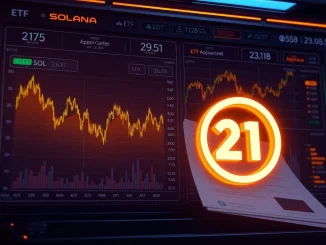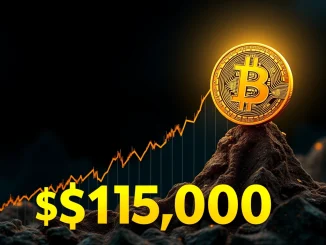
Are you a crypto enthusiast wondering how global economic shifts could impact your digital assets? A significant development is on the horizon that could reshape not just traditional finance but also the volatile world of cryptocurrencies: the impending US-EU Tariff Truce. This agreement, aiming to cap tariffs at a modest 15%, is more than just a trade deal; it’s a potential catalyst for widespread economic stability, and its ripple effects are already being keenly observed by crypto investors worldwide.
Understanding the US-EU Tariff Truce: A Path to Stability?
The United States and the European Union are on the cusp of finalizing a landmark tariff truce. This isn’t just another bureaucratic negotiation; it’s a strategic move designed to inject predictability into global trade. Imagine a world where trade wars are less frequent, and businesses can plan with greater certainty. That’s the vision behind this truce, which aims to cap tariffs at 15%—a significant reduction from the previously proposed 30%.
- A Precedent Set: This move mirrors the recent US-Japan trade agreements, signaling a broader effort to de-escalate unilateral trade actions that characterized previous administrations.
- Economic Predictability: For traditional markets, this deal promises to stabilize corporate earnings and reduce equity market volatility. Fewer trade barriers mean smoother supply chains and potentially higher profits for multinational corporations.
- Curbing Uncertainty: The core objective is to reduce the kind of macroeconomic uncertainty that has often driven speculative flows into cryptocurrencies, as investors sought alternatives to traditional assets.
This truce, if finalized, represents a concerted effort to foster a more predictable global economic environment. But what does this mean for assets like Bitcoin and Ethereum, which have often thrived amidst chaos?
How Will This Truce Influence Crypto Market Impact?
The relationship between global economic stability and cryptocurrency markets is complex, often exhibiting a dual nature. Cryptocurrencies, particularly Bitcoin, have historically served as both a safe-haven asset during times of geopolitical instability and a speculative vehicle driven by risk appetite. The US-EU Tariff Truce introduces a fascinating dynamic into this equation.
Crypto as a Safe Haven: A Diminishing Role?
During periods of heightened global tension, such as trade wars or geopolitical conflicts, investors often seek refuge in assets perceived as uncorrelated with traditional markets. Bitcoin has frequently been dubbed ‘digital gold’ in this context, offering a hedge against currency devaluation or market crashes. However, if the tariff truce successfully ushers in an era of reduced Trade Tensions and increased economic stability:
- Demand for Bitcoin and other cryptocurrencies as traditional hedges might weaken.
- Investors may find less incentive to move capital out of fiat currencies or equity markets.
- The narrative of crypto as a ‘crisis asset’ could temporarily recede, shifting focus to its technological merits and long-term adoption.
Crypto as a Speculative Vehicle: New Opportunities?
Conversely, a more predictable economic backdrop could open doors for a different kind of capital flow into crypto. As traditional markets stabilize and investor confidence grows, institutional players might become more comfortable allocating portions of their diversified portfolios to digital assets. This shift could be driven by:
- Long-term Growth Potential: With reduced immediate risks, the focus shifts to the underlying innovation and growth potential of blockchain technology.
- Diversification Benefits: Even in stable times, cryptocurrencies offer a unique asset class that can provide diversification benefits within a balanced portfolio.
- Regulatory Clarity: Often, periods of stability also coincide with greater regulatory clarity, which can attract more mainstream investment.
The recent U.S.-Japan deal briefly boosted risk appetite, showing how even localized trade agreements can have broader effects. Crypto prices, however, remain highly sensitive to both regulatory shifts and overarching macroeconomic signals, making the Crypto Market Impact of this truce a nuanced affair.
Navigating the Bitcoin Price Trajectory Amidst Global Shifts
The potential Bitcoin Price movements in the wake of the US-EU Tariff Truce are a hot topic among analysts. The current consensus suggests a fork in the road, heavily influenced by broader monetary policy and the success of de-escalating Trade Tensions.
The Bullish Scenario: Rate Cuts and Economic Confidence
Some analysts project that Bitcoin’s price could surge above $100,000. This optimistic outlook is largely predicated on the Federal Reserve implementing aggressive rate cuts. Why would rate cuts boost Bitcoin?
- Increased Liquidity: Lower interest rates typically mean more money flowing into the economy, seeking higher returns.
- Reduced Opportunity Cost: Holding non-yielding assets like Bitcoin becomes more attractive when the returns on traditional savings accounts or bonds are low.
- Inflation Hedge: While economic stability is the goal, aggressive rate cuts can sometimes signal concerns about future inflation, leading investors to seek inflation hedges like Bitcoin.
If the tariff truce creates a stable economic environment, it could give the Fed more leeway to pursue policies that indirectly support crypto valuations by preserving fiat purchasing power, or by encouraging risk-on behavior.
The Bearish Scenario: Lingering Trade Tensions and Uncertainty
Conversely, prolonged Trade Tensions or a breakdown in negotiations could see Bitcoin’s price fall to $80,000 or lower. Even with a truce, the broader implications for global trade and financial markets remain uncertain. Replicating the success of the U.S.-Japan agreement with the EU, without sacrificing key trade interests, is a significant challenge. In this scenario:
- Renewed Volatility: Persistent trade disputes reignite macroeconomic uncertainty, potentially leading to sell-offs across risk assets, including crypto.
- Flight to Safety (Traditional): Investors might opt for more traditional safe havens like the U.S. dollar or government bonds if economic instability returns.
- Dampened Speculation: A prolonged period of uncertainty could dampen speculative flows, as investors become more risk-averse.
For now, crypto markets are in a period of cautious recalibration, with outcomes closely tied to the evolving trade landscape and the delicate balance between stability and potential renewed tensions.
Beyond Bitcoin: Altcoins, Stablecoins, and the Quest for Economic Stability
While Bitcoin often takes center stage, the US-EU Tariff Truce will also have profound implications for the broader altcoin market and the role of stablecoins in maintaining Economic Stability within the crypto ecosystem.
Altcoins: Riding the Tech Wave or Facing the Storm?
Altcoins, which are highly correlated with tech stocks and broader market sentiment, are likely to experience heightened volatility. Their performance often mirrors that of growth-oriented equities. If the truce leads to genuine economic stability and a boost in investor confidence, altcoins could see a surge, riding the wave of renewed risk appetite. However, lingering uncertainties or unexpected shifts in trade policy could lead to sharp corrections, as these assets are typically more susceptible to market swings than Bitcoin.
Stablecoins: The Unsung Heroes of Hedging
Stablecoins like USDT and USDC play a crucial role, especially during periods of market recalibration. As traders hedge against potential fiat fluctuations or seek temporary refuge from crypto volatility, the adoption and trading volume of stablecoins may increase. They act as a bridge between the traditional financial system and the decentralized crypto world, offering a stable peg in an otherwise dynamic environment. Their increased use during uncertain times underscores their utility as a risk-management tool for crypto traders.
The Federal Reserve’s Hand: A Crucial Variable in Trade and Crypto
Adding another layer of complexity to the US-EU Tariff Truce is the Federal Reserve’s policy trajectory. The interconnectedness of trade and monetary policy cannot be overstated. Pressure from the White House for a significant rate cut (e.g., a 1% cut) highlights how political and economic forces converge to influence central bank decisions. This directly impacts the Crypto Market Impact.
If the tariff truce successfully fosters a stable economic environment, the Fed might find more room to maneuver with its monetary policy. For crypto, this could mean:
- Indirect Support for Valuations: A stable economy, coupled with potentially lower interest rates, could make traditional investments less appealing, indirectly pushing capital into alternative assets like crypto.
- Preserving Fiat Purchasing Power: If the Fed’s actions maintain the strength of fiat currencies, it reduces the immediate urgency for investors to seek inflation hedges, but it can also signal a healthy economic environment conducive to broader investment.
Conversely, if negotiations falter or the truce breaks down, reigniting Trade Tensions, the Fed might face different pressures. Such a scenario could:
- Reignite Speculative Trading: Investors might once again seek non-correlated assets, potentially pushing crypto prices higher as a hedge against renewed instability.
- Shift in Fed Focus: The Fed’s focus might shift from growth to managing inflation or preventing a recession, with unpredictable consequences for all asset classes.
The dance between global trade policy and central bank actions is a delicate one, and its rhythm will largely dictate the future sentiment and valuation within the crypto space.
Key Takeaways for Crypto Investors
The evolving landscape shaped by the US-EU Tariff Truce presents both opportunities and challenges for crypto investors. Here are some actionable insights:
- Monitor Global Trade News: Stay informed about the progress of the truce and any new developments in international trade relations. These directly influence broader market sentiment.
- Understand Crypto’s Dual Role: Recognize that crypto can act as both a safe haven and a speculative asset. Your investment strategy should adapt based on prevailing macroeconomic conditions.
- Diversify Wisely: Consider how your portfolio is balanced between Bitcoin, altcoins, and stablecoins. Altcoins carry higher risk but also higher reward potential in a stable environment.
- Watch the Fed: Federal Reserve policy announcements, especially regarding interest rates, will have a significant indirect impact on crypto valuations.
- Prepare for Volatility: Even with a truce, the crypto market remains inherently volatile. Be prepared for price swings and have a risk management strategy in place.
Conclusion: A Cautious Recalibration for Crypto
The impending US-EU Tariff Truce marks a pivotal moment in global economics, promising a degree of Economic Stability that has been elusive in recent years. For crypto markets, this isn’t a simple case of ‘good news for traditional markets equals bad news for crypto.’ Instead, it’s a nuanced recalibration. While reduced Trade Tensions might dampen the immediate demand for Bitcoin as a crisis hedge, the ensuing stability could pave the way for increased institutional adoption and a shift in focus towards crypto’s long-term value propositions.
The future Bitcoin Price and the performance of the broader crypto ecosystem will largely depend on the successful implementation of this truce, the Federal Reserve’s subsequent policy decisions, and how investors collectively interpret this new era of economic predictability. As always, staying informed and adapting your strategy will be key to navigating these exciting, yet uncertain, times.
Frequently Asked Questions (FAQs)
Q1: What is the US-EU Tariff Truce?
The US-EU Tariff Truce is a pending agreement between the United States and the European Union to cap tariffs at 15%, significantly lower than previously proposed rates. Its primary goal is to reduce global trade tensions, stabilize corporate earnings, and promote economic predictability.
Q2: How might the US-EU Tariff Truce affect the Bitcoin price?
The impact on Bitcoin’s price is dual. If the truce leads to genuine economic stability and reduced trade tensions, demand for Bitcoin as a safe-haven asset might decrease. However, a more predictable economic environment could attract institutional investors, potentially driving up the Bitcoin price. Aggressive Federal Reserve rate cuts could also push Bitcoin higher.
Q3: What is the expected Crypto Market Impact of this truce?
The crypto market impact is complex. Reduced macroeconomic uncertainty might lessen the appeal of cryptocurrencies as hedges. However, increased economic stability could encourage institutional investment and focus on crypto’s long-term growth potential. Altcoins might see volatility tied to tech stocks, while stablecoins could see increased use for hedging.
Q4: How do Federal Reserve policies tie into the trade truce and crypto?
The Federal Reserve’s monetary policy is closely linked to trade. If the tariff truce creates stability, the Fed might have more flexibility for rate cuts, which could indirectly support crypto valuations by increasing liquidity or making traditional assets less appealing. Conversely, renewed trade tensions could push investors back into crypto as a non-correlated asset.
Q5: Will this truce lead to overall Economic Stability?
The truce is designed to foster greater economic stability by reducing trade barriers and uncertainty. While it sets a positive precedent, replicating its success across all global trade relationships remains a challenge. Its long-term impact on global economic stability will depend on consistent policy and successful implementation.
Q6: Should I adjust my crypto investment strategy due to the truce?
It’s advisable to stay informed and consider how your portfolio is balanced. While the truce aims for stability, crypto markets remain volatile. Understanding Bitcoin’s dual role as a safe haven and speculative asset, monitoring Fed policies, and diversifying wisely are key strategies.



